experiment
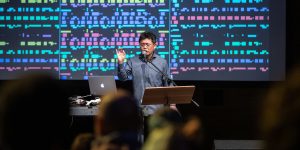
Voices from AI in Experimental Improvisation
Tomomi Adachi (JP), Andreas Dzialocha (DE), Marcello Lussana (IT)
Voices from AI in Experimental Improvisation is a project by Tomomi Adachi, Andreas Dzialocha and Marcello Lussana. They built an AI called “tomomibot” which learned Adachi’s voice and improvisation techniques using neural network algorithms. The performance raises questions about the logic and politics of computers in relation to human culture.
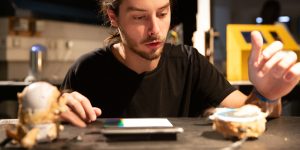
Das ‘Smart’ Unheimliche // The Smart Uncanny
Carlos Orti Roig (ES)
This project explores our relationship with daily-use AI consumer electronic products. It challenges the design techniques used to make AI products more ‘reliable’ and ‘comfortable’ from the consumer’s point of view. Three AI products have been re-aestheticised from an unheimlich (uncanny) perspective. By making the audience experiment with the ‘Anti-Alexa Experience,’ this project aims to promote socio-technical knowledge and introduce critical thinking towards daily AI products and services.
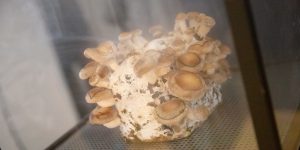
Growing Geometries – tattooing mushrooms
Theresa Schubert (DE)
Growing Geometries – tattooing mushrooms explores the morphology of fungi and evolution of geometrical shapes on living and growing membranes.
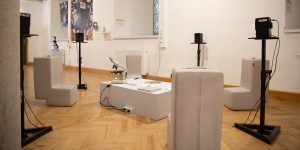
TARDIGRADA – von mikrobiotischen Lebenskünstlern
Maria Antonia Schmidt (DE)
The tardigrade or water bear, a microorganism, survives environmental conditions that hardly any other living creature can withstand. While researchers are working on deciphering the secrets of the tardigrade's survival, the media are throwing themselves at the cute bear and marketing it in all conceivable variations. In the end, the work poses the question of what sound these tiny creatures make. This is reason enough for the world's first tardigrade nano-ear experiment: a musical radio feature/4channel audio installation between science and absurdity.
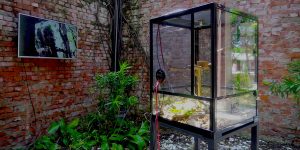
ZoomBx: KTV Sessions Vol II.
Rico Graupner (DE)
ZoomBx: KtV Sessions Vol II. focuses on the experimental exploration for real-time-driven composition of public soundscapes. Sound events and movement patterns inside a terrarium are tracked, interpreted, and acoustically applied to a concrete fusion with the outer soundscape. The result is an automated soundscape composition between randomness and determinism, from which questions about the cultural significance of designed sounds and the originality of acoustic phenomena can be deduced.
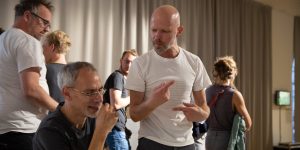
Introduction to Posthuman Aesthetics
Mindaugas Gapševičius (LT/DE)
Installation with devices and videos (2016-2019) These toolkits invite their users to carry out scientific experiments on a DIY level and be able to introduce their simplified, accessible versions to a broader community. The prerogative is to render and outline methods for independent research, opening the black box of empirical experiments to individuals across disciplines. Whether framing the discussion of political, economical, or cultural issues, the toolkits question the creativity of non-humans and do not presume humans to be the only creative force at work.
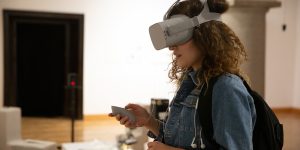
microplastic_hyperobject
Maria Degand (FR/DE), Leon-Etienne Kühr (DE)
Numbers and graphs are the essence of most scientific papers. They try to describe the world, facts, and problems. Microplastics are one of these problems. This artistic research is an example of how people can literally be put in these graphs. It looks at the real problem particle in this particle system. The design of experimental research is set up to simulate the experience of the hyperobject in virtual reality. Experiments on the scale in virtual reality and about connections in virtual space.
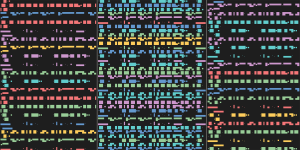
Voices from AI in Experimental Improvisation
Tomomi Adachi (JP), Andreas Dzialocha (DE), Marcello Lussana (IT)
Voices from AI in Experimental Improvisation is a project by Tomomi Adachi, Andreas Dzialocha and Marcello Lussana. They built an AI called “tomomibot” which learned Adachi’s voice and improvisation techniques using neural network algorithms. The performance raises questions about the logic and politics of computers in relation to human culture.

Mutual Understanding
Thomas Grill (AT)
Two acoustic agents incarnated by large horn loudspeakers are incessantly exchanging acoustic codes. Based on models of human vocalization, they develop their vocabulary independently from a natural language. In their ongoing discourse, they follow a common goal: to optimize the beauty of their own vocal expression.


